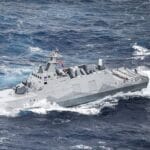At DSEI UK 2025 in London, British maritime engineering firm BMT unveiled its latest unmanned surface vehicle (USV) concept—MODUS (Modular Uncrewed Surface System). Designed with modularity and mission versatility at its core, MODUS is aimed at addressing a broad spectrum of naval operations including intelligence gathering, mine countermeasures (MCM), anti-submarine warfare (ASW), and maritime security. The platform reflects a growing trend in naval force design toward scalable autonomy and distributed capabilities.
MODUS Concept Overview: Modularity as a Design Philosophy
MODUS is not a single vessel but a system architecture built around interchangeable modules that can be reconfigured depending on mission requirements. The base hull is optimized for launch from a mother ship or shore facility and can accommodate various payloads including sonar arrays, electronic warfare suites, towed sensors, or weapon systems.
The core design features include:
- Modular payload bays: Capable of integrating ISR sensors, MCM tools like towed sonars or mine neutralization vehicles (MNVs), and ASW payloads.
- Autonomy suite: Compatible with NATO-standard control systems; supports supervised autonomy and remote control via C2 links such as Link-16 or SATCOM.
- Hydrodynamic optimization: Designed for low acoustic signature and high endurance in littoral or open-sea environments.
BMT emphasized that MODUS is scalable from smaller 6–8 meter variants up to larger 12+ meter hulls depending on mission scope. The design leverages existing commercial-off-the-shelf (COTS) components where feasible to reduce cost and accelerate fielding timelines.
Mission Profiles: From Mine Warfare to Persistent ISR
The modularity of MODUS allows it to support multiple mission sets across the naval warfare spectrum. At DSEI 2025, BMT showcased three primary configurations:
Mine Countermeasures (MCM)
In the MCM role—one of the most mature applications for USVs—MODUS can carry synthetic aperture sonar (SAS) arrays or deploy expendable mine neutralizers like Saab’s Sea Wasp or Atlas Elektronik’s SeaFox. Its low magnetic/acoustic signature makes it ideal for operations in mined waters without risking crewed platforms.
Intelligence Surveillance Reconnaissance (ISR)
A sensor-heavy configuration equips MODUS with EO/IR cameras, radar systems like SeaVue or Scanter series, AIS receivers and SIGINT packages. This setup supports maritime domain awareness missions such as border patrols or surveillance of contested sea lanes.
Anti-Submarine Warfare (ASW)
A less common but emerging role for USVs involves towing variable depth sonar (VDS) arrays or deploying passive acoustic sensors to detect submarines in littoral zones. While limited by power constraints compared to manned platforms like frigates or helicopters, MODUS could augment ASW coverage as part of a multi-platform sensor grid.
Crewless by Design: Autonomy Stack and Control Interfaces
BMT has partnered with several UK-based autonomy developers to integrate an open architecture software stack into MODUS. This includes route planning algorithms using AI-based obstacle avoidance and behavior trees tailored for specific missions such as loitering over an area of interest or following predefined search patterns.
The system supports both line-of-sight RF control via tactical datalinks and beyond-line-of-sight operation via satellite communications. It is also compatible with NATO STANAG-based C4ISR networks—enabling integration into multinational task forces under frameworks like NATO’s Maritime Unmanned Systems Initiative (MUSI).
Deployment Concepts: From Littorals to Blue Water
BMT envisions MODUS being deployed from multiple platforms:
- Mothership deployment: From amphibious ships or frigates using davits or stern ramps—similar to how the Royal Navy deploys its current ARCIMS USVs.
- Littoral launch: Shore-based deployment from trailers for coastal defense missions.
- AUV/ROV synergy: Acting as a communication relay node between underwater assets and command centers during complex MCM operations.
This flexibility aligns with evolving naval doctrines emphasizing distributed lethality and manned-unmanned teaming across domains. By offloading dull/dangerous tasks to uncrewed assets like MODUS, navies can preserve high-value crewed platforms for strategic roles while enhancing operational tempo.
Status & Roadmap: From Concept Reveal to Trials
DSEI UK 2025 marked the public debut of the full-scale prototype mockup of MODUS. According to BMT representatives at the show floor interviewed by Naval News and other outlets including Janes Defence Weekly:
- An operational prototype is expected by Q4 2026 pending funding partners from UK MoD or international clients;
- BMT has conducted hydrodynamic modeling trials using CFD simulations since early 2024;
- The company aims to begin sea trials in UK waters by mid-2027;
No formal procurement program has yet been announced by the Royal Navy; however BMT confirmed that discussions are ongoing under the umbrella of the Royal Navy’s Project HECLA—which explores future autonomous MCM capabilities—and potential alignment with NATO MUSI objectives.
The Strategic Context: Growing Demand for Modular Autonomy
The unveiling of MODUS comes amid increasing demand among NATO navies for scalable uncrewed maritime solutions capable of operating independently or within manned-unmanned teams. Programs such as Belgium-Netherlands rMCM initiative (with ECA Group), France’s SLAMF program by Thales/Naval Group consortium, and U.S. Navy’s LCS-based MCM modules reflect this shift toward distributed autonomous systems tailored per mission need rather than fixed-role vessels.
BMT’s approach with MODUS mirrors broader trends seen across allied navies—including emphasis on open architectures compliant with STANAG standards; use of COTS components; rapid reconfiguration between roles; low-signature hull designs; and AI-enabled autonomy stacks that reduce operator burden while increasing operational tempo across contested littorals.








